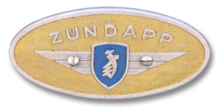Zündapp
 |
|
| Industry | Machine tools, motor vehicles |
|---|---|
| Founded | 1917 |
| Defunct | 1984 |
| Headquarters | Germany |
| Products | Detonators, motorcycles, microcars, sewing machines, mopeds |
Zündapp (a.k.a. Zuendapp) was a major German motorcycle manufacturer founded in 1917 in Nuremberg by Fritz Neumeyer, together with the Friedrich Krupp AG and the machine tool manufacturer Thiel under the name "Zünder- und Apparatebau G.m.b.H." as a producer of detonators (Zünder- und Apparatebau is German for Igniter and Apparatus). In 1919, as the demand for weapons parts declined after World War I, Neumeyer became the sole proprietor of the company, and two years later he diversified into the construction of motorcycles.
Following World War II, Zündapp expanded into the microcar, moped and scooter markets. The company collapsed in 1984.
Zuendap.biz markets markets bicycle and electric bicycles using the Zundapp name and logo. while Zuendapp.com markets "enduro-sport" motorcycles under the Zundapp brand.
The first Zündapp motorcycle was the model Z22 in 1921. This was the Motorrad für Jedermann ("motorcycle for everyone"), a simple, reliable design that was produced in large series. Zündapp's history of heavy motorcycles began in 1933 with the K-series. The "K" refers to the type of drivetrain that these models used, Kardanantrieb, meaning enclosed driveshaft with two universal joints. Zündapp introduced the enclosed crankcase (then a novelty). The series encompassed models from 200 to 800 cc displacement and was a major success, increasing Zündapp's market share in Germany from 5% in 1931 to 18% in 1937.
The Zündapp KS600, first released in 1938, had a 28 hp (21 kW) horizontally opposed twin cylinder motor with overhead valves displacing 597 cc (36.4 cu in). The KS600 was often coupled with a Steib sidecar, the BW38 (Beiwagen 1938). The BW38, fitted with the B1 (Boot no. 1) sidecar body was produced between 1938 and 1941 and supplied exclusively to the Wehrmacht. While the KS600 was discontinued and eventually replaced by the purpose-built KS750, its motor was to be the only remnant to live beyond the destruction of war. When Zündapp returned to motorcycle production in the late 1940s, it chose to reuse the KS600's motor to power the KS601 with few modifications.
...
Wikipedia
